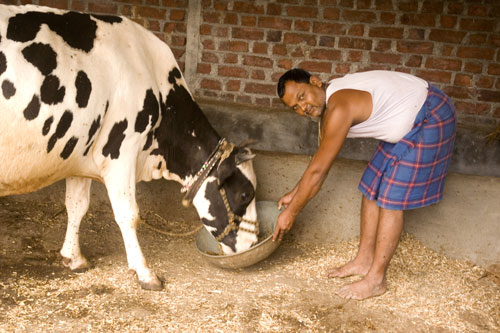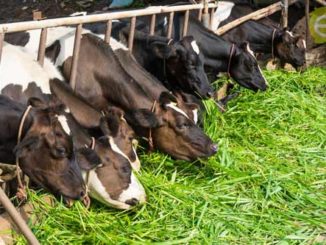Urea poisoning is one of the more commonly suspected toxicities of cattle in the Top End. Urea is used as a source of non-protein nitrogen (NPN) in feed supplements. In ruminants, nitrogen from urea is released in the rumen as ammonia and can be used by rumen microflora to synthesize protein. This protein then becomes available to the animal through the normal processes of digestion and absorption. However, if more urea is consumed than the rumen organisms can metabolize, the ammonia is absorbed from the rumen into the blood. The ammonia is then converted back to urea in the liver and is then excreted by the kidneys. This pathway can easily be overwhelmed when excess ammonia and urea circulate in the blood, causing poisoning. Poisoning can occur rapidly from a few minutes to four hours after consumption. Suspect urea poisoning if cattle are found dead close to the supplement.
Causes of urea poisoning
- Excess consumption of urea.
- Sudden introduction to high quantities of urea.
- Irregular consumption of urea.
- Wet supplement containing urea.
- Urea separating out from the supplement after transport; re-mix prior to feeding.
Symptoms of urea poisoning
Severe colic, shivering, staggering (incordination), weakness bloating, tremors, growing, forced rapid breathing, marked jugular pulse, violent struggling and bellowing etc. The animals walk with a proppy gait. The animal goes down on its sternum and later rolls over on to its side. Excessive salivation, frothing at mouth, laboured breathing and paralysis are common signs. As death nears, animal becomes cyanotic, dyspnoic, anuric and hyperthermic. Follow drenching of acetic acid with drenching of large volume of water (Cattle 20-30 litres for adults). The rationale is that water lowers the rumen temperature and dilutes the reacting medium, while acetic acid lowers rumen pH preventing ammonia absorption.

Diagnosis of urea poisoning
The most useful diagnostic indicators are the history of access to urea and the signs shown by live, affected animals. Laboratory tests of blood samples are not very helpful and no specific changes are seen at post-mortem examination.
The following are general indicators of urea poisoning:
- History of access to urea.
- Laboratory testing of collected blood and rumen fluid immediately after death may indicate urea poisoning.
- Post-mortem – bloat; white foam in airways; ammonia odour when the rumen is opened; rumen pH 7.5 – 8.0.
Often a large pool of rumen fluid is seen on the ground at the nose of the beast. The animals usually suffer severe bloat and the fluid buildup in gases forces the rumen fluid out through the mouth when the animal dies. Keep rumen and reticulum samples in formalin for subsequent diagnosis.
Treatment of urea poisoning
- Diluted acetic acid up to 10-12 litres of 6 per cent acetic acid along with 2040 liters cold water for cattle buffalo. Goat and sheep – 0.5-1 litre of kitchen vinegar or 5 per cent acetic acid. Vinegar orally 2 ml/kg body weight mixed in 2 to 5 litres of water can be drenched (for cattle and buffalo 2-8 litres, sheep and goat 0.5-1 litre).
- Electrolyte solution by IV.
- Injection of adrenergic blocking agents.
- Parenteral Calcium-Magnesium preparations like Mifex, Calborol, Calgonate200-300 ml IV to relieve tetanic seizures.
- Supportive therapy with isotonic saline solutions by IV route to correct dehydration
| The content of the articles are accurate and true to the best of the author’s knowledge. It is not meant to substitute for diagnosis, prognosis, treatment, prescription, or formal and individualized advice from a veterinary medical professional. Animals exhibiting signs and symptoms of distress should be seen by a veterinarian immediately. |






Be the first to comment